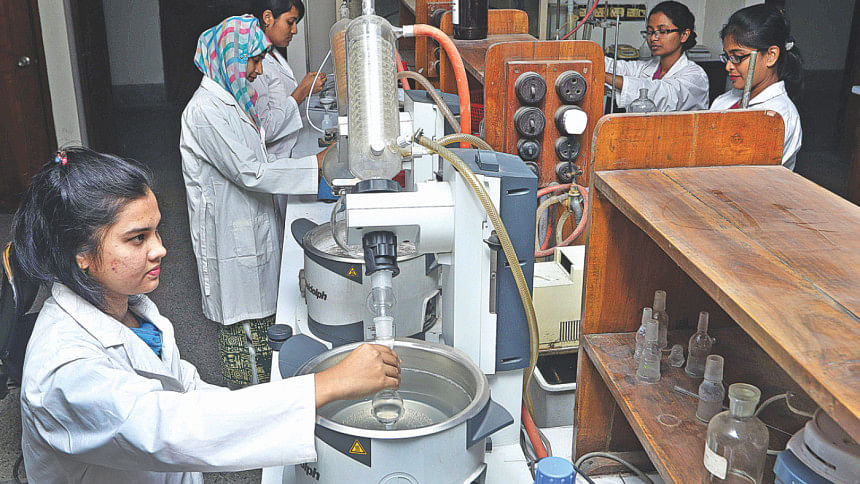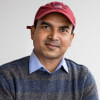The science fiction about women

I am at a chemistry lab at Dhaka University where no girl is crying or talking about love. With a steely resolve and monastic devotion, they are working shoulder to shoulder with the boys to determine the level of contamination in foods. One of them is analysing pesticide residue in vegetable samples while another is estimating sulfur drugs in chicken and beef.
Nothing they are doing here supports the outrageous quip Tim Hunt, the Nobel Prize winning English biochemist made about women scientists at an international conference last year in Seoul: "Let me tell you about my trouble with girls … three things happen when they are in the lab … You fall in love with them, they fall in love with you and when you criticise them, they cry."
This sexist attitude is precisely why women remain underrepresented in Physics, Chemistry and Mathematics in almost every country in the world. According to the most recent UNESCO Science Report, women account for only 28 percent of science researchers across the world while the number is about 14 percent in Bangladesh. MA Aziz, Professor of Physics and Dean of Faculty of Sciences at DU says, "In the PhD and MPhill programmes we prefer women students as they are more serious about their studies. In Physics, Chemistry and Math women secure top positions in the merit list on a regular basis. They also do very well as faculty members."
We may be far from the proportion that is ideal but women and girls are much higher levels of success in science than fiction tells us. Nilufar Nahar, Professor and Chairperson of Department of Chemistry of DU says, "30-40 percent of our students are girls who pass the entrance exam on the basis of merit, not any quota. More women are studying sciences at the university level in Bangladesh than in the US, the UK and other European countries."
This is news to me. What then explains the low number of female researchers? Professor Nahar says, "It's not lack of merit or discrimination in allocation of funds and opportunities in research, scholarship or admission, it is the societal attitude and lack of family support. There is a misconception that women do not do well in physical sciences. And research demands long hours in the lab. Sometimes families do not like them to stay away from home for such long hours. Women have to juggle full-time research and homemaking."
The students I talk to echo the professor's view. Jannatun Noor Jeouty, a final year student who is conducting research on micro plastic says, "The teachers and the staff are very supportive of us. We have to work in the lab till late in the evening. We don't face any problems." Rehnuma Tabassum, a Masters student who is doing research on the pollution of the waters in the Sundarbans is thankful to both teachers and the staff for making them feel safe and secure at the department. Rafiza Islam, a PhD student working on antibiotic residue in foods says she is being able to carry out her research without worry due to her husband's support.
Bright, motivated and committed, most of them want to go to the US or Europe for higher studies and then return to give back to the society. And they are. Tanvir Muslim, a Professor at the department says, "Our students have a 100 percent success rate in securing visa. The number of female students going abroad, however, is low. Family members want them to be married and have kids."
The female students of other science related subjects are doing equally well. Rafiqul Islam, Professor of Applied Chemistry and Chemical Engineering and Former Dean of Faculty of Engineering and Technology says, "Girls constitute one third of our total students while one fourth of our faculty members are female. I have given lectures in universities in Germany, Switzerland, Russia, China and Japan and I can say that the number of women studying sciences in our country is higher than that in these countries. They do better in research."
Why is this remarkable accomplishment of women little known to the public? What has caused the false myth of girls' intrinsic unsuitability for science? "I think the media have an important role to play here," Professor Rafiqul Islam says. "Our women are doing better than those in the developed countries. For the past three years they have been securing the top position in my department. They usually do better in research. However, their participation in engineering is lower."
Now that's a sad reality. Take a walk around engineering universities and colleges—not only in this country but anywhere in the world—and you will see an overwhelming percentage of males studying there. When our girls outnumber boys in medical education and biological sciences, why are there so few female students in the engineering sciences? Alia Rahman Papri, a final year student of mechanical engineering at Bangladesh University of Engineering and Technology (BUET) says, "When I enrolled, there were only 15 girls out of a total of 180. The notion that women do well in the medical sciences but not in engineering is a fallacy. The number of girls is relatively low in engineering sciences not because they are less qualified, it's because a fewer number of girls takes the entrance exam."
The obvious question is why. Alia Rahman says, "There is a myth that one has to lift heavy things and do labourious physical work while studying mechanical engineering. People express their surprise when I tell them that I am studying mechanical engineering. What people don't understand is that mechanical engineers are not mechanics or technicians. It is true that fewer girls go for engineering after passing HSC but once they get in they do better than 60 percent of the boys." Alia is conducting research in biomedical engineering and is planning on going to the US for further studies.
How are women doing in other universities of the country? Md Nurul Alam, Professor of Physics and former Dean of faculty of Science of Jahangirnagar University says, "Ours is a residential university. We admit students according to the number of residential seats available each year. I would say, in the undergraduate programme, out of a total of 70 students at least 25 are women each year."
Again, the numbers are encouraging as they translate into 35 percent of the total number of students in physics. Elsewhere in the country in Rajshahi University, in the physical sciences, 14 percent teachers and 26 percent students are women. In the biological sciences, the percentages are 16 and 47 respectively, according to Arun Kumar Basak, Professor Emeritus at the Department of Physics. "Girls have many limitations imposed on them by society," says Professor Basak, an internationally renowned nuclear and atomic physicist. "After marriage their research is often interrupted. If our society has to advance keeping with the time we are in, more girls have to get into science and they should be encouraged to do so. We as a society should make it easy for them to study science rather than create barriers for them."
Identifying the root causes of women's unequal participation in science is hardly simple. As with any complex issue there is no clear Achilles' heel, no single underlying reason that explains it. The barriers are multilayered. Shamima K Choudhury, Professor of Physics at the University of Dhaka says, "Women are neglected in terms of recognition even after doing exceptionally well. Women in scientific professions face discrimination in terms of employment, promotion and retention. Barriers that limit women's entry to careers in science include lack of grants and funding, balancing family and career, gender biases, scarcity of job openings, having and rearing children, lack of mentors and role models, child care support, laboratory space and lack of confidence. It is said that women have to work twice as hard as men to show that they are equally competent. Encouraging women to take science should start at the secondary level."
As the country takes the leap forward to more prosperity, Bangladesh needs science and science needs more women. And as for the young women at the Chemistry lab at Dhaka University, I wish they find love on or off laboratories without paying any attention whatsoever to Tim Hunt's preposterous remark.
The writer is a member of the Editorial Team.

 For all latest news, follow The Daily Star's Google News channel.
For all latest news, follow The Daily Star's Google News channel. 



Comments